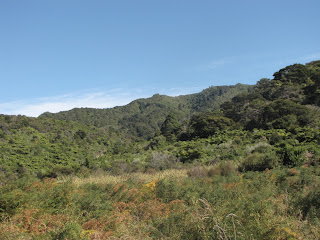We'd heard that the forecast was not good, and there were a few showers overnight, but the weather didn't look too bad when we got up.

After a certain amount of morning faff, we got someone to take the first and last photo of the two of us together in the park.

With a final look down the beach,

we head off up into the trees again.

It was considerably rougher out at sea than it had been so far. Fortunately the wind was blowing the people we'd met at the campsite the night before in the direction they wanted to go.

In what seemed like no time, we were back at Anapai Bay.


The entrance to the camping area looks like it should have trolls hiding in it or something.
Soon after that we were back to Totaranui.

In a mixture of paranoia and thinking we might want to sit on the beach for a while, we'd booked ourselves onto the last water taxi of the day. Sitting around in the rain at Totaranui for 3 hours didn't seem like it would be much fun, and luckily we managed to move our booking onto an earlier taxi.

And then I got to play at trying to take photos from the back of a fast moving speedboat in slightly rough seas...

The first part of the ride was quite bumpy, and we could see why kayaking in this part of the park is discouraged; it really wasn't that windy and the swell wasn't that large, but it would have been no fun to paddle through, and it wouldn't have had to been much bigger to have been pretty dangerous, I guess.
One of the the sights was this very smooth large boulder:

After we'd got into the calmer waters around Tonga island, we paused off shore a bit to look at the few seals that had bothered to clamber onto the rocks on this cloudy day.


And then we were zooming off again.

The weather looked fairly grim further inland; not a good day to be doing the Abel Tasman inland track, I guess.

And then after an hour or so in the boat, we were back at Maharau. Our walk was over, and we'd had a pretty glorious time.
The Abel Tasman isn't really like other multi-day walks we've been on. For one thing, the easy access by water taxi means that at least the southern of the park is really quite busy, mostly with people doing day walks between to taxi stops. Nothing too horrendous, but still a surprise. The other main thing is that, again compared to other walks we've done, the walk is just plain easy. No serious climbing, very well formed paths and short days; it felt a bit like we were cheating! But, as we kept reminding ourselves, we were on holiday! In fact, it ended up being a combination tramp/beach holiday, which turns out to be a pretty good combination. It would also be a great walk to do with children, particularly if you took the option of having your overnight bags carried by water taxi.
In summary: if you get the chance, do this walk.


















































